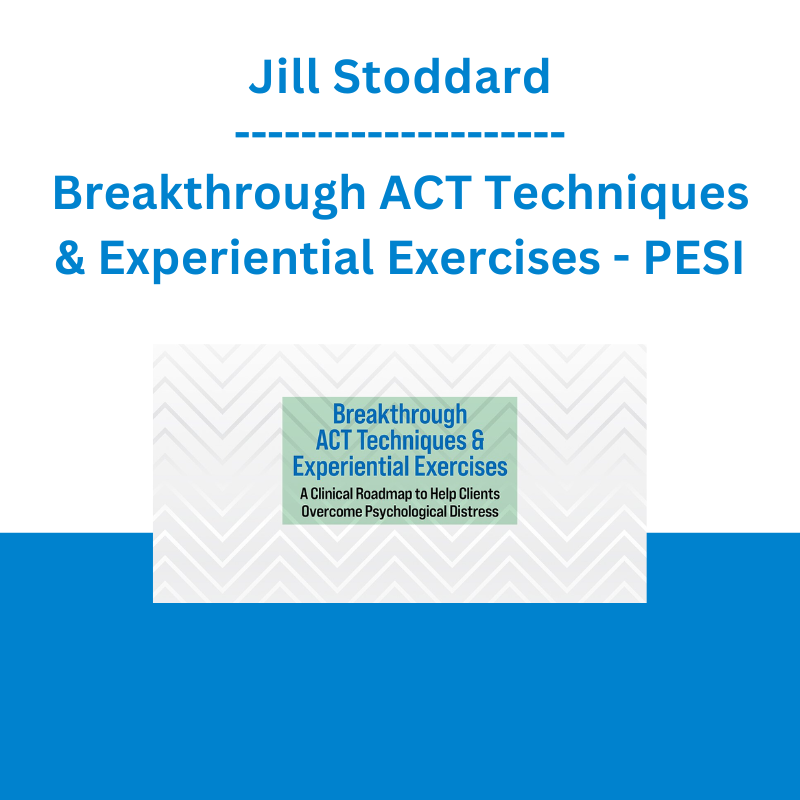*** Proof of Product ***
Exploring the Essential Features of “Jill Stoddard – Breakthrough ACT Techniques & Experiential Exercises: A Clinical Roadmap to Help Clients Overcome Psychological Distress – PESI”
Speaker: Jill Stoddard, PhD
Duration: 6 Hours 14 Minutes
Format: Audio and Video
Copyright: Oct 08, 2021
Media Type: Digital Seminar
Description
Have you ever found yourself at the bottom of your clinical toolbox when working with clients? Whatever the diagnosis—the problem is usually the same—therapy stalls and you don’t know what to do next.
Watch peer-reviewed ACT trainer and author, Jill Stoddard, PhD, for this Acceptance and Commitment Therapy (ACT) experiential. Dr. Stoddard will teach you how to skillfully apply the six core processes of ACT to build the psychological flexibility your clients need to overcome psychological distress.
You’ll learn breakthrough techniques and salient exercises—not found in other ACT trainings—that will help your clients stay in the moment with all their thoughts and feelings, without defense, and ready to make choices that help them heal.
You’ll leave this training being able to successfully apply ACT in therapy as well as teach your clients—even the most challenging—how to put ACT into practice themselves!
Speaker
Jill Stoddard, PhD
Jill Stoddard, PhD, is a clinical psychologist and director of The Center for Stress and Anxiety Management. She is the author of two books: Be Mighty: A Woman’s Guide to Liberation from Anxiety, Worry, and Stress Using Mindfulness and Acceptance and The Big Book of ACT Metaphors: A Practitioner’s Guide to Experiential Exercises and Metaphors in Acceptance and Commitment Therapy. Dr. Stoddard is an award-winning teacher, peer-reviewed ACT trainer, and co-host of the Psychologists Off the Clock podcast. She is a frequent podcast guest, regular contributor to Psychology Today, and has had her writing appear in Scary Mommy, Thrive Global, The Good Men Project, and Mindful Return. Dr. Stoddard received her PhD from Boston University in 2007.
Speaker Disclosures:
Financial: Jill Stoddard is the founder and director for The Center for Stress and Anxiety Management. She is an author and receives royalties. Dr. Stoddard receives a speaking honorarium and recording royalties from PESI, Inc. She has no relevant financial relationships with ineligible organizations.
Non-financial: Jill Stoddard is a member of the Anxiety and Depression Association of America; Association for Contextual and Behavioral Science; and Association for Behavioral and Cognitive Therapy.
Objectives
- Differentiate pain from suffering to help clients understand the basis of ACT and psychological flexibility.
- Propose three forms of experiential learning and practice in ACT.
- Conduct a creative hopelessness exercise to help clients identify the function and cost of their behaviors.
- Determine the impact of learning history (i.e., behavioral patterns from the past) on clients’ current patterns of unworkable behavior.
- Demonstrate experiential exercises to help clients practice acceptance, defusion and values identification.
- Differentiate goals from values and articulate the importance holding outcomes lightly.
Outline
The ACT Model: The Roadmap to Psychological Flexibility
- Empirical support for treatment across diagnoses
- Functional Contextualism
- Relational Frame Theory (RFT)
- Limitations of the research & potential risks
Deconstructing the Pathology of Emotional Pain
- When anxiety, social comparison, and avoidance of uncertainty are helpful
- How trying to problem solve our emotions leads to challenging behavior
- What client’s pain tells us about their values
- The difference between pain and suffering
Help Clients Get Unstuck Through Experiential Defusion Exercises
- Avoid the trips and traps of language that result in challenging behaviors
- Rely on experience over language to get desired outcomes
- Ways of getting experiential with your clients
- Role-play: Asking questions in an experientially focused way
Pave the Way Toward Acceptance
Experiential Exercises to Teach Clients the Function and Cost of Experiential Avoidance
- What clients get out of problematic behavior
- The cost of experiential avoidance and its impact on values
- Walking clients through ‘creative hopelessness’ (function/cost of behaviors)
- Make space for the experience of discomfort
- Fun ways to practice willingness, mindfulness, awareness, and acceptance
Identify Client Behavior Patterns from Youth
Family of Origin Triggers that Lead to Unworkable Behavior
- Origin of the patterns
- How they protected then
- How they hurt now
- Case studies: Child abuse, overinvolved parents, narcissistic parent
Build Psychological Flexibility…Don’t Change Thoughts and Feelings!
Experiential Exercises to Help Clients Let Go of the Fight Against Pain
- Know firsthand the difference between
- Emotion avoidance and emotion acceptance
- Thought suppression and thought defusion
- Change client’s relationship to their thoughts, self-limiting beliefs that stall treatment
- Choices, processes, and steps that keep clients in the moment
Values and Committed Action:
Experiential Exercises to Help Clients Identify and Live their Values
- Experiential practice for identifying client values
- Overcoming obstacles to valued living
- How to hold outcomes lightly in-service of committed action
Target Audience
- Social Workers
- Counselors
- Psychologists
- Physicians
- Marriage and Family Therapists
- Addiction Counselors
- Psychotherapists
- Case Managers
- Nurses
- Mental Health Professionals
- Therapists
Please see the full list of alternative group-buy courses available here: https://lunacourse.com/shop/









